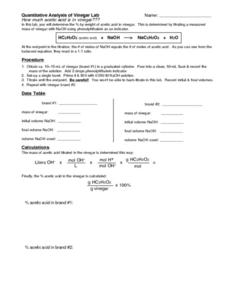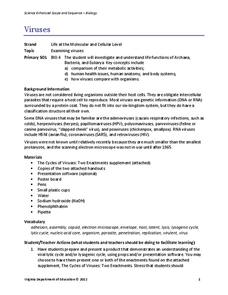Curated OER
Quantitative Analysis of Vinegar Lab
In this quantitative analysis worksheet, learners perform a lab to determine the amount of acetic acid in vinegar by doing a titration. They use an indicator phenolphthalein to determine the endpoint of the titration.
Curated OER
Quality Control at Kality Krunchers Dill Pickle Factory
In a hypothetical scenario, food chemists use titration to concoct a brine solution for producing the crunchiest pickles. They also analyze store-bought pickle juices. In addition to reinforcing titration techniques, the lesson requires...
Nuffield Foundation
Investigating the Effect of Temperature on the Activity of Lipase
How does temperature affect lipase activity? Young scholars conduct an experiment to collect data on the interaction of lipase at different temperatures. They add lipase to a solution of milk, sodium carbonate, and phenolphthalein and...
Virginia Department of Education
The Ratio of Surface Area to Volume
Demonstrate the ratio of surface area to volume in your high school class by using phenolphthalein, gelatin, and an onion. Intrigue the class by leading a discussion on osmosis and diffusion, then making "scientific jello." Participants...
Curated OER
Acid-Base Titration
Students determine the concentration of an acid using titration. For this acid-base titration lesson plan, students determine the concentration of an unknown hydrochloric acid solution using phenolphthalein as an indicator and a known...
Curated OER
More Acid-Base Indicators
Students explore acids, bases, and indicators. They use turmeric solution, phenolphthalein, and goldenrod paper to determine the acidity and basicity of a variety of common household substances. A worksheet is included to record test...
Royal Society of Chemistry
A Microscale Acid-Base Titration
Watch as acids and bases put smiles on their faces. Young chemists learn the concept of acid-base titration firsthand in a microscale experiment. Working groups collaborate, titrate, then use their data to determine the concentration of...
Curated OER
Infectious Disease Detectives
Students participate in a simulation of how diseases are transmitted. Each student holds a test tube, with only one containing the "disease" while the others have water. They move around the room until told to stop. Using droppers to...
Curated OER
Viral Hijackers
Students discover how viruses effect living organisms. Focusing on HIV, they explain why it is unique and how it attacks the immune system. They simulate the spread of viruses through an experiment using water containing sodium...
Curated OER
Invisible Ink
Students wxplore acids and indicators by watching a demostration in which "magic" ink appears. They duplicate the demonstration by writing magic messages using phenolphthalein solution and painting the message with vinegar to show it.
Curated OER
A Simulation of the Spread of HIV
Learners participate in a simulation to illustrate the spread of HIV. They use phenolphthalein, water and test tubes to simulate the spread of the virus and discuss results and variables after the activity.
Curated OER
How Germs Spread
Students conduct a test to help them visualize the spread of
germs. They identify that a pandemic is an epidemic (an outbreak of an infectious disease) that spreads across a large region or even worldwide. Finally, students state...
Curated OER
Invisible Ink - Demonstration
Learners observe a demonstration that shows that the indicator, phenolphthalein, is a chemical that displays different colors depending on either the acidity or the basicity of the environment. They use the substance to reveal secret...
Curated OER
Virus Tracker
Sixth graders will simulate the spread of a virus such as HIV through a population by "sharing" (but not drinking) the water in a plastic cup with several classmates. Although invisible, the water in a few of the cups will already be...
Curated OER
Vision Props of Signed Numbers
Students explore the concept of titration. In this titration lesson, students observe acid and alkaline reacting. Students discuss pH factor, measuring acidity, neutrality, and alkalinity of liquids. Students put the pH of liquids on a...
Virginia Department of Education
Mystery Iron Ions
Young chemists perform an experiment to determine if a compound is iron (II) chloride or iron (III) chloride. Then they determine the formula, balance the equation, and answer analysis questions.
Curated OER
The Alkaline Earth Metals
Students investigate the characteristics of alkaline earth metals. In this alkaline earth metals lesson plan, students experiment with a variety of alkaline earth metal compounds and perform tests to observe their properties. Students...
Virginia Department of Education
Viruses
Germs, parasites, and viruses, oh my! Facilitate a lesson on viruses as individuals explore functions of Archaea, Bacteria, and Eukarya. They learn how viruses compare with other organisms in nature and how they contribute to health...
Curated OER
Cholera and the Scientific Method
Five individuals in the class are "infected" with cholera! The rest of the class serves as investigators to discover the source of the outbreak. They test drinking fountains around campus for contamination. You, of course, will secretly...
Curated OER
The Spread of Aids
This is an effective simulation of how communicable diseases such as AIDS can be spread throughout a population. Classmates exchange samples from their individual cups of liquid: one of them containing a dilute NaOH solution, and the...
Pingry School
Determination of the Molar Mass of an Unknown Acid
Acids and bases have a love-hate relationship. They balance each other so nicely, but they are complete opposites! Learners use these concepts and titration to calculate the molar mass of an unknown substance. The experiment document...
Santa Monica College
Titration of Vinegar
Titration calculations require concentration. The 10th lesson plan in an 11-part series challenges young chemists to use titration in order to determine the molarity and mass percent in concentrated vinegar. Analysis questions encourage...
Virginia Department of Education
Aspirin Analysis
Laughter may be the best medicine, but aspirin is also important. Young chemists analyze aspirin tablets using titration in this lab experiment. They then repeat the entire experiment using a different aspirin brand.
Curated OER
Solubility Product of a Hydroxide
Students determine the solubility product constant and the concentration of a hydroxide. In this solubility product lesson plan, students use a solution of calcium hydroxide to neutralize a known concentration of hydrochloric acid. They...
Other popular searches
- Hiv Aids Lab Phenolphthalein
- Hiv Phenolphthalein
- Disease Phenolphthalein
- Phenolphthalein Std Lesson
- Lab Phenolphthalein
- Obtaining Phenolphthalein
- Phenolphthalein Solution
- Phenolphthalein Std
- Hiv Aids Phenolphthalein

























